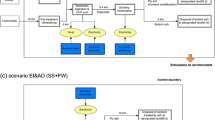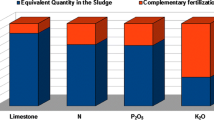Abstract
The majority of night soil (human excrements) is source separated from other sewage water and treated at night soil treatment plants in Japan. Efforts have been made to achieve material recovery from this organic mass, together with other organic wastes such as kitchen wastes and manure, by expanding the functions at night soil treatment plants. These facilities with expanded function are called ‘sludge retreatment centers’, which are promoted by the Japanese Ministry of Health and Welfare. Potential environmental impacts of sludge retreatment using two presently available systems in Japan are analyzed for comparison. Systems compared are: 1) Mebius system, a high-speed fermentation process with methane gas recovery and compost production and 2) a comparable system with a basic composting process. The functional unit for this study is concurrent treatment of 40 t/d of kitchen waste, 40 m3/d of night soil, and 60 m3/d of private sewage treatment tank sludge. Impact assessment on Global Warming (IPCC 1996, 20 yrs.), Acidification Potential (De Leeuv — AP), Eutrophication Potential (De Leeuv- EP) and Resource Index (Fava/SETAC & Heijungs) all indicated that sludge retreatment with Mebius system provides a better environmental performance. The main reasons are: 1) production of power using recovered methane and 2) reduction of sludge volume by digestion, which leads to reduction of fuel required for sludge drying. The collection and treatment of night soil and kitchen wastes involves many economic and social factors. Therefore, more studies with different functional units on these systems should be made to obtain a more complete picture that can be used for decision-making processes. The results of this study can be used as a starting point.
Similar content being viewed by others
References
Suzuki T, Tohya Y (1986): Night Soil Treatment by the Nitrified Liquor Recycling Process. Water Science and Technology, v. 18 no.7/8, Tokyo, Japan, p 352
Ministry of Health and Welfare Home Page (http://www.mhw.po.jp/houdoe//1108/h0830-3 14h.html): Summary of Generation and Treatment of Municipal Wastes in 1996. Ministry of Health and Welfare, Environmental Health Bureau, Water Supply and Environmental Sanitation Dept., Waste Management Div., Tokyo, Japan
Ministry of Health and Welfare, Environmental Health Bureau, Water Supply and Environmental Sanitation Dept., Waste Management Div. (1998): Handbook of Waste Management Facility Operation Guidelines. Japan Waste Management Association, Tokyo, Japan, p 71
GaBi 3 (1998): Software, Databases and Documentation for Life Cycle Engineering. IKP University of Stuttgart and PE Product Engineering GmbH, Stuttgart, Germany
IPCC (Intergovernmental Panel on Climatic Change) (ed.) (1996): Climate Change 1995. IPCC Secretariat, World Meteorological OrganizationThe Science of Climate Change. IPCC Secretariat, World Meteorological Organization. MIT University Press, Cambridge
De Leeuw F (1993): Assessment of the Atmospheric Hazards and Risks of New Chemicals: Procedures to estimate ‘Hazard Potentials’. National Institute f Public Health and Environmental Protection, p 1324 ff
Fava J, Consoli F et al. (1993): A Conceptual Framework for Life-Cycle Assessment (Sandestin-Report), SETAC-USA, Pensacola, FL (USA)
Heijungs R et al. (1992): Environmental Life Cycle Assessment — Guide. Centrum voor Milieukunde (CML), Leiden
Iriyama K et al. (1999): An LCA Study of Two Sludge Retreatment Processes: Ebara Mebius System vs. Paddle-type Composting and J Water Treatment System, an Internal Report for Ebara Corporation
Ministry of Agriculture, Forestry, and Fisheries (Agricultural Production Bureau, Fertilizer and Machinery Division) (1998): Statistical Abstract of Fertilizers: Association of Agriculture and Forestry Statistics, Tokyo, Japan, p 49–57
Yoneyama A et al. (1999): Methane Fermentation of Organic Wastes by Mebius Demonstration Test Plant. Ebara Jiho, No. 185
Author information
Authors and Affiliations
Corresponding author
Rights and permissions
About this article
Cite this article
Strauss, K.I., Wiedemann, M. An LCA study on sludge retreatment processes in Japan. Int. J. LCA 5, 291–294 (2000). https://doi.org/10.1007/BF02977582
Received:
Accepted:
Issue Date:
DOI: https://doi.org/10.1007/BF02977582




